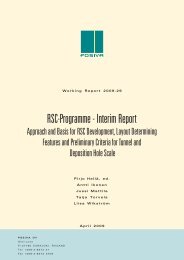Bentonite Mineralogy Part 1: Methods of Investigation - Posiva
Bentonite Mineralogy Part 1: Methods of Investigation - Posiva
Bentonite Mineralogy Part 1: Methods of Investigation - Posiva
You also want an ePaper? Increase the reach of your titles
YUMPU automatically turns print PDFs into web optimized ePapers that Google loves.
39<br />
The d-value <strong>of</strong> the 060-peak (also called 06-33) allows the distinction between<br />
dioctahedral and trioctahedral clay minerals. In most <strong>of</strong> the studied samples the 060peak<br />
is around 1,49 - 1,50 A that is typical <strong>of</strong> dioctahedral smectites montmorillonite<br />
and beidellite, and also <strong>of</strong> kaolinite that is present in most <strong>of</strong> the samples (Table 7 -3).<br />
The only sample with d-value typical <strong>of</strong> trioctahedral clay minerals, 1,54 A, is the<br />
Friedland clay.<br />
Table 7-3. d-values (A) <strong>of</strong> the 060-peakfor studied samples and for standard minerals<br />
(data from Bailey, 1980 and Brindley, 1980)<br />
Sample/run 1 2 3<br />
MX-80 1,4997 1,4962<br />
BH-200 1,4972 1,4940<br />
Kutch 8937 1,4952 1,5035 1,5027<br />
Kutch 8938 1,4987 1,4957<br />
Kutch 8939 1,4974 1,4938<br />
Kutch 8940 1,4979 1,5014<br />
Milos H 1,4962 1,4920<br />
Milos E 1,4967 1,4966<br />
Milos A 1,5025 1,4996<br />
Friedland 1,5433 1,5417<br />
Rokle 1,4973 1,5027 1,5022<br />
Strance 1,5012 1,5054 1,5039<br />
Dnesice 1,4902 1,5050<br />
Skalna 1,4988 1,4994 1,4920<br />
kaolinite 1,490<br />
montmorillonite 1,492 - 1,504<br />
nontronite 1,521<br />
chlorite 1,538- 1,549<br />
biotite 1,538<br />
muscovite 1,499

















